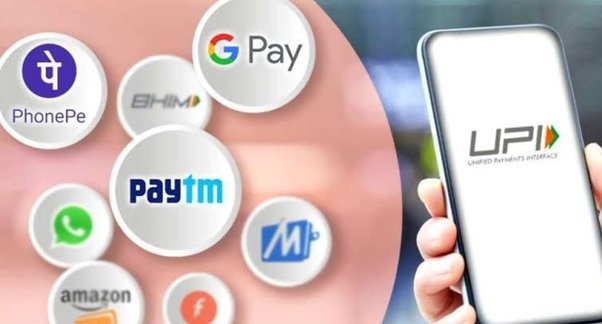THE REVOLUTION CALLED UPI
Paper presented by Swathi Krishna Sunil(SRO064625)
INTRODUCTION
In ancient times , our ancestors used the barter system to exchange goods and services. Then came the evolution of money which changed our lives drastically. Every materialistic thing on the earth was valued in terms of money. People started exchanging goods & services with printed notes. This is continued for years and still is carried on.
Technology is advancing faster than ever more. India has changed a lot in terms of use of technology. In 2015, a call was given for a ‘Digital India’, enabling technology to reach millions of lives all over the country. The movement, which transformed the economic landscape of India. Digital India movement is also one of the primary boosters for the ‘Digital Payment’ arena that saw the rise of numerous digital payment apps. The advantage of using these apps was that it allowed users to link multiple credit and debit cards under a single umbrella. They also gave attractive offers and discounts for using their apps. Consecutively, the idea of making payments directly from your bank account, without the need to carry debit cards, was seen as a lucrative market. Thus, came into existence UPI – Unified Payment Interface. UPI was officially launched in 2016 for public use.
UPI-Unified Payments Interface
Unified Payments Interface (UPI) is a payment system that allows users to link more than one bank account in a single smartphone app and make fund transfers without having to provide IFSC code or account number. This is a real-time payment system where funds are credited instantly on a real-time basis. UPI has been developed by the National Payments Corporation of India (NPCI) and is regulated by the Reserve Bank of India (RBI).UPI is slowly becoming the most preferred form of digital payment. This is a one-stop solution for using separate bank accounts to carry out transfers from a single app. It allows all account holders to send and receive money through their smartphones with a single identifier – the Virtual Payment Address (VPA) commonly known as the UPI ID – without needing any bank account information. Customers often do not need to know the IFSC code of the beneficiary or payer, bank account details, etc., and this allows the transaction to be quicker. So, customers will make quicker transactions with their friends and merchants.
The primary objective of UPIs is facilitating seamless transfer of funds between two bank accounts. Here are the transactions you can perform through your UPI App apart from Sending Money:
- Request Money: This function allows the user to initiate a collection request by entering the Virtual Payment Address (VPA). In addition, using your UPI App, money can also be transferred using Mobile if it is registered with BHIM or *99#. It is also mandatory that the mobile number of the customer be connected to the bank account.
- Scan & Pay: Customers can pay by scanning the QR code using 'Scan & Pay' and creating QR codes in the Payment Program.
- Transaction Records: This option allows a user to search the history of transactions. This will also allow a person to analyze his or her spending pattern requests.
- Profile Management: The profile management option in any UPI app lets users display the static QR code and payment addresses generated. The QR code can be downloaded and exchanged via various messaging applications such as WhatsApp, Email, etc.
- Check Bank Account Balance: Use this option to check the bank account that is connected to the UPI app along with the status of the PIN. This feature also allows a user to review their balance of accounts.
Who are the primary participants in UPI?
UPI is constituted of the following players:
- Payer PSP -The Payer PSP is the Remitter PSP that provides the PSP app to the Remitter.
- Payee PSP- Payee PSP refers to the beneficiary PSP, which enables UPI transactions to receive funds from the beneficiary.
- Remitter Bank -A Remitter Bank is a bank that holds the payer’s bank account and receives the Debit of the UPI instruction from the payer to be executed in real-time.
- Beneficiary Bank – Beneficiary Bank refers to the bank that holds the receiver’s bank account and receives the credit of the UPI instruction from the payer to be done, either in real-time or periodically through a settlement process.
- NPCI -The National Payments Corporation of India (NPCI) is an umbrella organization responsible for operating retail payments and settlement systems in India. NPCI is a joint initiative of the Reserve Bank of India (RBI) and the Indian Banks’ Association (IBA), established under the Payment and Settlement Systems Act, 2007, to build a highly secure payment and settlement infrastructure in India.
- Bank Account holders - A bank account holder is someone in whose name a bank account is operated.
- Merchants - A merchant is a person who sells directly to the public, either in a store or via the internet.
Note: PSPs (also known as Merchant Service Providers) are third-party companies that assist business owners in accepting online payments via several payment methods, such as online banking, credit cards, debit cards, e-wallets, cash cards, and more. Essentially, they ensure that your transactions get from point A to point B safely and securely.
What Makes Unified Payments Interface Unique
These features make UPI a very unique platform:
- With just one singe mobile app any person can have access to various bank accounts.
- It facilitates the Immediate transfer of money via mobile devices.
- There is two-factor Authentication for making payment, thereby ensuring security.
- Removes the need to carry physical cash notes where ever you go.
- You can easily share your bills with friends.
- Over the Counter Payments, Barcode based payments, and Utility Bill Payments can also be made.
- You can make merchant payment with a single app or in-app payments.
- You can raise complaints directly from the mobile app.
- You can make donations, disbursements, and collections easily.
Benefits of UPI for Banks:
- There is a universal application for one transaction
- This is a single click Two Factor authentication
- It is safer and more secure
- It enables easy transaction
- Unique Identifier
- Payment basis Single
Benefits of UPI for Merchants:
- Easier fund collection
- There is no risk of storing the customer's virtual address
- This is suitable for e-Com and m-Com transaction
- Tap customers do not need credit/debit cards
- In-App Payments (IAP)
Benefits for UPI for Customers:
- It is a single application for accessing various bank accounts
- There is round the clock availability
- You can easily raise a complaint from the mobile app directly
- The use of Virtual ID is secure
Apps with UPI Feature in India
Below is the list of App that provides UPI Feature:
- PhonePe
- Paytm
- BHIM app
- MobiKwik
- Google Tez
- Uber
- Chillr
- Paytm Payments Bank
- SBI Pay
- iMobile
- Axis Pay
- BOB UPI
Contribution of UPI for the Indian Economy
UPI is considered as the most successful deep-tech innovation of India around the world. In December 2019, seeing the success of UPI, the giant- tech Company Google suggested Federal Reserve Board to follow UPI as example in developing FedNow (real-time payment system of USA). Nations such as Brazil, Bahrain, Saudi Arabia, Singapore and European Union are now trying to imitate the success of UPI in their own market. As of 2021, ,UPI made India a leader in global real-time payment market followed by China and South Korea. UPI has also became a popular payment option for initial public offerings (IPOs).
In partnership with NSDL Payments Bank and NPCI, ToneTag launched VoiceSE which will enable 40 crore feature phone users to make UPI payment using voice in Hindi, Tamil, Telugu, Malayalam, Kannada, and Bengali languages.
UPI 2.0 was launched which enabled users to link their overdraft accounts. Users were also able to pre-authorize transactions by issuing a mandate for specific merchant. This version also included a feature to view and store the invoice for the transactions. An AutoPay facility for recurring payments was also added.
From 8 June 2022, RBI allowed linking RuPay credit cards with UPI. Customers can now make credit card payments using UPI, in the absence of a physical card. NPCI is working on a real-time feature that will reduce the 24 hours’ time period taken by banks to unblock funds over time-out or transaction decline to 30 seconds. The service was officially launched on 20 September 2022. On 7 December 2022, RBI announced that UPI will upgrade from single-block-single to single-block-multiple debit for recurring transactions and investments in securities. The feature will help the user block funds for specific purpose and release it when needed.
The RBI Governor Shaktikanta Das has introduced New UPI (Unified Payment Interface) named UPI123Pay for featured mobile. The initiative enables the under-covered rural market to get access to UPI service through their normal feature phone. The major features of UPI123Pay are a three-step payment method, internet connection is not required, instant bill payments, and account balance check. To use this new UPI service the consumer should link their phones with bank links. Governor Shaktikanta has also launched DigiSaathi, a helpline to solve problems relating to digital payments.
With an intention to increase the consumer base, The Ministry of Finance clarified that the government is not considering charging UPI services. The Ministry of Finance also added that the UPI service providers' need to meet the of cost recovery through other means.
According to the recent data released by the National Payments Corporation of India (NPCI), UPI transactions increased from 678 crores in September 2022 to 730 crores in October 2022. The 7.7 % increase translated to Rs.12.11 lakh crore as the total value of transactions in October compared to Rs.11.16 lakh crore earned in September.
Around 777 million Indian consumers shop across the border in 2021. To make ease of payment, NPCI International Payments Limited (NIPL) signed memorandum of understanding (MoU) with UK based PPRO Financial on 17 November 2021 to expand the acceptance of UPI into foreign markets especially in China and United States which accounts for half of all international transaction coming from India.On 26 January 2022, UK based fintech startup Transact365 enabled UPI for global merchants with real time currency conversion facility that will help them do business in India independent of local presence. As per NPCI and RBI mandate, banks, payment service providers (PSPs) and third-party application providers (TPAPs) in India must enable international acceptance through UPI from 30 September 2022.
Conclusion
Life has changed drastically with the invention of technology. Gone are those days when you had to stand in long queues to make the transfer of money, to get your pension, to withdraw money. Now we can just do it with just one touch on our smartphone sitting on our sofa. Life has become easier than ever before.
Digital India Scheme has paved the way for this much improvement in our life. Digital payment can not only help in making payment easier but also help people have a better outlook on life and improve their lifestyles. If we are able to put more time, energy, and money into the field of technology, we can make India the next Big Economy.


